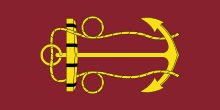The Board of Admiralty

Flag of the Lord High Admiral
|
|
| Agency overview | |
|---|---|
| Formed | 1628 |
| Preceding agency | |
| Dissolved | 1964 |
| Superseding agency | |
| Jurisdiction | Government of the United Kingdom |
| Headquarters | Admiralty Building Whitehall Westminster, London |
| Agency executive | |
| Parent agency | Department of the Admiralty |
The Board of Admiralty was established in 1628 when Charles I put the office of Lord High Admiral into commission to exercise the office of the Lord High Admiral. As that position was not always occupied, the purpose was to enable management of the day to day operational requirements of the Royal Navy; at that point administrative control of the navy was still the responsibility of the Navy Board, established in 1546. This system remained in place until 1832, when the Board of Admiralty became the sole authority charged with both administrative and operational control of the navy when the Navy Board was abolished. The term Admiralty has become synonymous with the command and control of the Royal Navy, partly personified in the Board of Admiralty and in the Admiralty buildings in London from where operations were in large part directed. It existed until 1964 when the office of First Lord of the Admiralty was finally abolished and the functions of the Lords Commissioners were transferred to the new Admiralty Board and the tri-service Defence Council of the United Kingdom.
The office of Lord High Admiral was created in around 1400 to take charge of the Royal Navy. It was one of the Great Officers of State. The office could be exercised by an individual (as was invariably the case until 1628), by the Crown directly (as was the case between 1684 and 1689), or by a Board of Admiralty. The office of the Lord High Admiral from creation was the titular head of the Royal Navy they were primarily responsible for policy direction, operational control and maritime jurisdiction of the service. On the death of the Duke of Buckingham in 1628 his office of Lord High Admiral was put into commission by King Charles I, six Lords Commissioners of the Admiralty were appointed to execute the office jointly. In 1638 the office of Lord High Admiral was revived, but throughout the rest of the seventeenth century there were periods when the office was again in commission and even when there was a Lord High Admiral, he was often advised by a separate Admiralty Council, which was virtually a Board of Admiralty under another name. Finally in 1708 the Board of Admiralty became the normal instrument for governing the navy operationally on a day to basis, however the responsibility for the day to day administrative affairs of the naval service lay with another authority known as the Navy Board it was established earlier by King Henry VIII in 1546 which had evolved out of the Council of the Marine, there was an exception for the period 1827 to 1828, when the office of Lord High Admiral was temporarily revived for William, Duke of Clarence, later King William IV.
...
Wikipedia
